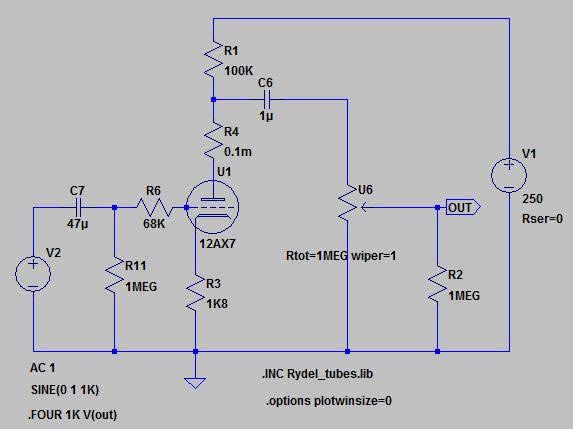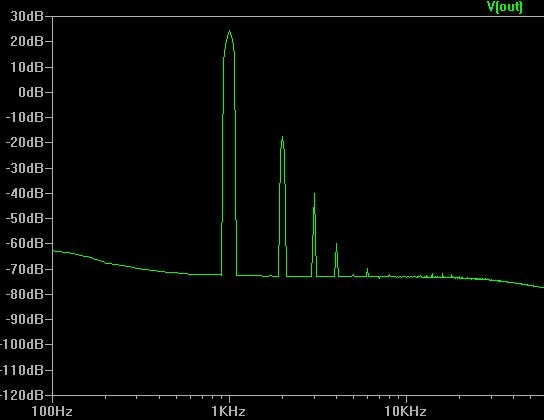I play amplified acoustic guitar through a tube buffer and onto a regular mixer mic preamp and I really like the way the tube softens up the various pickups I use and helps reduce the harshness you can get when driving acoustic pickups hard as well as loving the "old school" vibe. I wanted to take this further and develop a simple tube preamp to also get some gain and some basic EQ. To this end I strung a classic Fender 3-band tonestack between a couple of opamps set up to match the Fender tube source and load impedances to see what kind of sounds and EQ I could get, and despite everyone insisting that this type of tone control only being useful for electric guitars and overdrive, I managed to dial in some very useful sounds indeed for my acoustics
To keep things simple I thought why not try for a classic Fender electric guitar amp style thing as I love that chimey bell like clean sound you can get with single coil electrics..
triode gain stage >> tonestack >> volume pot >> cathode follower >> transformer >> balanced out.
But as it is for acoustic, aim for minimum distortion (maybe a little 2nd harmonic to make it worthwhile using tubes) and the highest headroom I could get. So I started to design by Google, as my tube knowledge is practically non-existent, and try and sim some circuits in LTSpice to see what I can do. However so far success has eluded me. Either I get too much distortion or clipping or I get clean but not enough gain to compensate for the losses in the tone stack. I am hoping it is just me not knowing how to bias tubes correctly!!
My basic (essential) requirements are:
1. 1.0 Mohm input impedance (works best with the pickups I use)
2. High headroom (minimum signal capability around 1.0V Pk)
3. About 25dB first stage gain to overcome the tonestack loss and give a working final signal level.
4. Preferably use either 1x 12AX7 (too much gain?) or 1x 12AU7 (not enough gain?) as I have these to hand. I do not care about the signal inversion as I can correct this on the output transformer wiring.
5. Lowest possible distortion from this type of circuit (with the tone circuit bypassed)
The closest I can get is from a pinched preamp circuit using a 6922 tube from here…
http://www.shine7.com/audio/6922_pre.htm
And plonking the tone stack in the middle of it like this…
https://sites.google.com/a/noratel.co.uk/ray/tube%20preamp.JPG
Seems to cover all the bases in sim land, but is this possible with 12AX7 or 12AU7 as I don’t want to shell out for a 6922 tube only to find the circuit (and possibly the whole idea) sucks!!?? With these two tubes I can try before I buy. Can any of you tube gurus give me some help here, is this possible or am I going to have to rethink?
To keep things simple I thought why not try for a classic Fender electric guitar amp style thing as I love that chimey bell like clean sound you can get with single coil electrics..
triode gain stage >> tonestack >> volume pot >> cathode follower >> transformer >> balanced out.
But as it is for acoustic, aim for minimum distortion (maybe a little 2nd harmonic to make it worthwhile using tubes) and the highest headroom I could get. So I started to design by Google, as my tube knowledge is practically non-existent, and try and sim some circuits in LTSpice to see what I can do. However so far success has eluded me. Either I get too much distortion or clipping or I get clean but not enough gain to compensate for the losses in the tone stack. I am hoping it is just me not knowing how to bias tubes correctly!!
My basic (essential) requirements are:
1. 1.0 Mohm input impedance (works best with the pickups I use)
2. High headroom (minimum signal capability around 1.0V Pk)
3. About 25dB first stage gain to overcome the tonestack loss and give a working final signal level.
4. Preferably use either 1x 12AX7 (too much gain?) or 1x 12AU7 (not enough gain?) as I have these to hand. I do not care about the signal inversion as I can correct this on the output transformer wiring.
5. Lowest possible distortion from this type of circuit (with the tone circuit bypassed)
The closest I can get is from a pinched preamp circuit using a 6922 tube from here…
http://www.shine7.com/audio/6922_pre.htm
And plonking the tone stack in the middle of it like this…
https://sites.google.com/a/noratel.co.uk/ray/tube%20preamp.JPG
Seems to cover all the bases in sim land, but is this possible with 12AX7 or 12AU7 as I don’t want to shell out for a 6922 tube only to find the circuit (and possibly the whole idea) sucks!!?? With these two tubes I can try before I buy. Can any of you tube gurus give me some help here, is this possible or am I going to have to rethink?






























![Electronics Soldering Iron Kit, [Upgraded] Soldering Iron 110V 90W LCD Digital Portable Soldering Kit 180-480℃(356-896℉), Welding Tool with ON/OFF Switch, Auto-sleep, Thermostatic Design](https://m.media-amazon.com/images/I/41gRDnlyfJS._SL500_.jpg)




